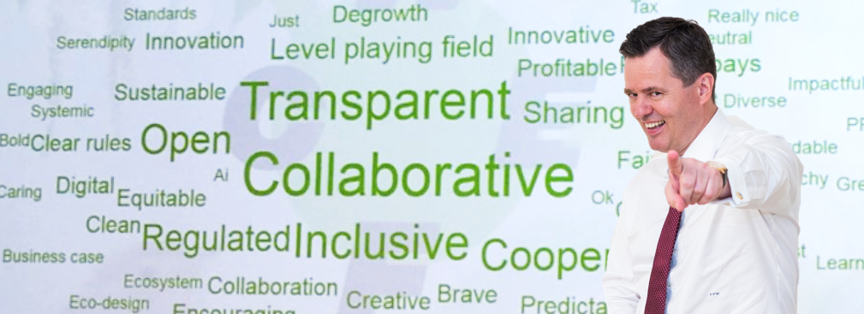Greta Thunberg is currently giving us an impressive demonstration of what has long been reality. The way we consume resources in our current economic and business models will no longer work in the long term.
The term “consume” says it all
We extract raw materials from nature, process them into products, which we then use or consume and ultimately throw away. One of the currently most important indicators of the performance of a country, an economy – the gross national product / per capita – is getting better if we throw away more, buy new and waste recklessly.
Transportation is also very cheap – resources such as fuel, road and air are consumed simply because, for example, food from far away is slightly cheaper than regional products. Any consequences for the climate and environment, damage to health through noise and dirt are often inadequately priced. Only when there is a shortage and high costs are associated with it is care taken to ensure reuse or recycling.
Circular Economy as a sustainable foundation
Circular economy follows a completely different basic model here, which includes much more than just material and energy efficiency. The aim is to design products in such a way that they remain in use for as long as possible, are also used jointly in sharing models, and can also be repaired, upgraded, rebuilt or at least recycled at the material level.
The following overview from the EllenMcArthur Foundation illustrates the changed basic model in a comparatively simple way – both for technical products and for biologically renewable products such as food. Products and materials are recycled as far as possible. Much less waste is produced, which is then suitable in the appropriate form as a raw material for recycling or for utilization in biological conversion processes.

© Ellen MacArthur Foundation
Threat or opportunity?
This approach can be seen as a disadvantage for existing value streams, or as an opportunity and potential for new business models. In particular, models that involve sharing, service, product preservation, repurposing and modernization, and are usually labor-intensive, are among the winners.
The awareness of many consumers, which is now on the move, the priorities in the new government program and the success of funds that invest in companies with a circular economy show that actively addressing the circular economy is extremely important. The “Cradle to Cradle” standard supported in Austria by Quality Austria is also an important driver here and identifies such products.
WCEF – Forum for a sustainable future
In the World Circular Economy Forum 2019 in Helsinki, examples were shown how extreme and ambivalent the present is:
One-third of all food becomes waste and discarded in the value chain. Other products that we produce, transport and trade are also not used. Extrapolating from the Helsinki example, if all cars were used optimally, only about 4% of the cars currently available would be needed.
On the one hand, new digital business models often contribute dramatically to “throw away” (cheap returns are often simply disposed of). On the other hand, digitally based platforms are the foundation of successful sharing economies. In these models, consumers no longer become end users of goods, but rather users by means of “pay per use” with subsequent maintenance and transfer to new users.
This would mean producing significantly fewer products, but in a completely different design – repairable, maintainable, of higher quality and durable. Products are no longer made for individual owners, but for use by communities.
Positive transformation prospects
Many concrete examples were shown in Helsinki and also large multinationals like IKEA or PHILIPS presented convincingly within the next decade (until 2030) to rely only on products that also have the capacity for circular economy.
In transformation, all organizations – from governments to corporations and NPOs – are challenged to rethink their approach to the long-term future. It requires interconnectedness of our economy, collective effort, and collaborative change with multiple key levers already working in the short term.
Make things happen!
Of course, the “circular economy” approach is changing all innovation, product design, and supply chains in particular. Actions must be reviewed, strategies reflected upon and revised. For example, changing procurement, demanding Circular Economy compliant products is an action that all organizations can implement immediately – this creates a pull effect and changes the way everyone acts. Incidentally, we also have this lever in our hands as consumers.

